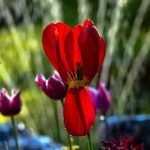Are you looking for fresh ideas for narrow side gardens? These often overlooked spaces have the potential to become beautiful and functional outdoor areas. With the right design and plant choices, even the narrowest of side gardens can be transformed into a lush and inviting space. In this article, we will explore various ways to maximize the potential of narrow side gardens, from understanding the challenges they present to practical tips for maintenance.
Narrow side gardens pose unique challenges due to limited space and sunlight. However, with careful planning and creativity, these constraints can be turned into opportunities for creating a truly unique outdoor oasis. By embracing verticality, choosing the right plants, incorporating optical illusions, and adding functional features such as seating areas or storage solutions, you can make the most of your narrow side garden.
In addition to exploring design and planting ideas, we will also discuss the importance of proper maintenance to keep a narrow side garden beautiful and tidy. From incorporating water elements like fountains or small ponds for tranquility to enhancing ambiance with outdoor lighting, there are countless ways to make the most of your narrow side garden.
Whether you’re dealing with a tight alleyway or a slim strip of land between properties, this article will provide you with inspiration and practical tips for making the most of your space.
Understanding the Challenges
Narrow side gardens present a unique set of challenges when it comes to gardening and landscaping. These spaces often have limited sunlight exposure and restricted area for planting, making it tricky to create a thriving garden. However, with the right approach and ideas for narrow side gardens, it is possible to transform these compact spaces into beautiful and functional outdoor areas.
When working with a narrow side garden, one of the main challenges is the limited space for planting. With little room for traditional garden beds, it’s essential to embrace verticality. Consider utilizing wall space for planting by installing hanging planters, trellises, or vertical gardens. This not only maximizes the available space but also adds visual interest to the area.
In addition to limited space, narrow side gardens may also face issues with sunlight exposure. To address this challenge, opt for plants that thrive in low light conditions or are shade-tolerant. Choose low-maintenance and space-saving options such as ferns, hostas, mosses, and certain types of ivy that can flourish even in shaded areas. It’s important to carefully consider the specific lighting conditions of your narrow side garden and select plants accordingly to ensure their success.
Another approach to combatting limited space and sunlight in narrow side gardens is creating optical illusions and using mirrors to give the illusion of depth. Incorporating elements such as mirrors strategically placed on walls or fences can make the garden appear larger than it actually is. Additionally, using techniques like diagonal lines or varying heights for plant arrangements can create a sense of depth and spaciousness in a confined area.
- Utilize wall space for vertical gardening
- Choose shade-tolerant plants like ferns and ivy
- Create optical illusions with mirrors and strategic plant arrangements
By addressing these challenges creatively, you can overcome the limitations of narrow side gardens and turn them into inviting outdoor spaces that are both visually appealing and functional.
Embracing Verticality
When it comes to narrow side gardens, one of the biggest challenges is working with limited space and sunlight. However, embracing verticality can be a game-changer in maximizing the potential of these small areas. Utilizing wall space for planting is a great way to make the most of the available space while also adding visual interest to the garden.
One idea for narrow side gardens is to install vertical garden planters or trellises on the walls. This allows you to grow an array of plants, including flowers, herbs, and even small vegetables, without taking up valuable ground space. You can also consider using hanging planters or wall-mounted pots to add greenery to your vertical garden.
In addition to traditional potted plants, you can also explore creative options such as installing a living wall. This involves creating a vertical garden using a framework filled with soil and plants. Not only does this add beauty to your narrow side garden, but it also provides additional insulation for your home, helping to regulate temperature and improve air quality. Embracing verticality not only maximizes space but also adds a unique and eye-catching element to your outdoor area.
When choosing plants for your vertical garden, opt for low-maintenance and space-saving options. Look for species that are well-suited for vertical growth and thrive in the conditions of your narrow side garden. By carefully selecting the right plants and utilizing wall space effectively, you can transform your narrow side garden into a lush and vibrant oasis that defies its limited dimensions.
Choosing the Right Plants
When it comes to choosing the right plants for narrow side gardens, it’s essential to opt for low maintenance and space-saving options that can thrive in limited sunlight. With the right selection, you can make the most of your narrow space and create a lush, green oasis. Here are some ideas for plants that are perfect for narrow side gardens:
- Bamboo: This fast-growing plant is an excellent choice for narrow side gardens as it adds height and privacy without taking up too much horizontal space.
- Vertical Garden Plants: Consider using climbing vines such as ivy or creeping fig to cover walls and fences, maximizing vertical space.
- Dwarf Trees: Look for varieties such as dwarf citrus or compact fruit trees that can thrive in containers and do well in small spaces.
- Herbs and Succulents: These low-maintenance plants are perfect for narrow side gardens, as they do not require much sunlight and can be grown in small pots or vertical planters.
In addition to choosing the right plants, it’s important to consider the overall aesthetic and function of your garden. Think about mixing different textures, heights, and colors to create visual interest despite the limited space. You may also want to incorporate edible plants or fragrant flowers for added enjoyment.
Ultimately, the key is to select plants that will thrive in your specific growing conditions and will require minimal upkeep. By carefully considering your options, you can create a beautiful and functional garden that makes the most of your narrow side space.
Creating a Sense of Depth
When working with a narrow side garden, creating a sense of depth can be a great way to visually expand the space and make it feel more inviting. One effective way to achieve this is by incorporating optical illusions and mirrors into the design. By strategically placing certain elements, you can trick the eye into perceiving a larger area than actually exists.
Strategic Planting and Pathways
One effective optical illusion for narrow side gardens is to create pathways and borders using plants of varying heights. By placing taller plants at the back or in the center of the garden, and gradually transitioning to shorter plants towards the front or edges, you can create the illusion of depth. Curving pathways can also add visual interest and make the space appear larger than it is.
Adding Mirrors
Mirrors are another fantastic way to make a narrow side garden seem larger than it really is. By strategically placing mirrors on the walls or fences, you can reflect light and greenery, giving the impression of an extended outdoor space. Just be mindful not to overdo it, as too many mirrors can become overwhelming and distracting.
Incorporating optical illusions and mirrors into your narrow side garden design can help maximize the potential of your space while adding visual interest. These simple yet impactful ideas can transform a cramped area into a welcoming oasis where you will love spending time outdoors. With some creativity and strategic planning, even the narrowest of side gardens can become a beautiful and inviting extension of your home’s living space.
Designing Functional Features
When it comes to narrow side gardens, maximizing the use of space is essential. One way to make the most of this limited area is by incorporating functional features such as a small seating area or storage solutions. These additions not only serve a practical purpose but also contribute to the overall aesthetics of the garden.
Building a Small Seating Area
Even in a narrow side garden, it is possible to create a cozy and inviting seating area. Consider installing a built-in bench along one of the walls, or opt for space-saving foldable chairs and tables that can be easily stored when not in use. Adding comfortable cushions and outdoor textiles can instantly transform this space into an intimate relaxation spot.
Storage Solutions for Narrow Side Gardens
Incorporating clever storage solutions is crucial for keeping a narrow side garden organized and clutter-free. Utilize vertical wall space for hanging racks or shelves to store gardening tools, pots, and other essentials. Additionally, investing in multi-functional furniture pieces with hidden storage compartments can help maximize the use of space while keeping the garden visually appealing.
These functional features not only add practical value but also contribute to the overall design and ambiance of a narrow side garden. By carefully planning and incorporating these elements, it is possible to make the most out of even the smallest outdoor spaces.
Incorporating Water Elements
When it comes to designing narrow side gardens, incorporating water elements can add a sense of tranquility and elegance to the space. Fountains and small ponds not only create a soothing ambiance but also serve as focal points in the garden. These water features can be particularly beneficial in narrow spaces, as they offer a sense of depth and expand the visual perception of the area.
One idea for incorporating water elements in a narrow side garden is to install a small fountain against a wall or in a corner. This not only maximizes space but also creates a peaceful atmosphere with the sound of flowing water.
Another option is to add a small pond, which can be designed to fit the dimensions of the space. A carefully placed pond can create a reflective surface that adds depth to the garden, making it feel larger than it actually is.
In addition to adding aesthetic value, water elements in narrow side gardens can also attract wildlife such as birds, butterflies, and even small amphibians. By carefully selecting and incorporating these features into the design of a narrow side garden, homeowners can transform their limited outdoor space into a vibrant and serene oasis.
Lighting Up the Space
When it comes to maximizing the potential of narrow side gardens, outdoor lighting plays a crucial role in enhancing the ambiance and functionality of the space. By strategically placing lights, you can not only illuminate the garden for practical purposes but also create a warm and inviting atmosphere for evening enjoyment. There are various ideas for incorporating outdoor lighting in narrow side gardens that can transform the space into a stunning and functional outdoor area.
One popular option for lighting up narrow side gardens is to use string lights or fairy lights. These delicate and dainty lights can be easily strung along fences, trellises, or pergolas to add a magical twinkle to the garden. Additionally, they are flexible and can be used to define different areas within the narrow space, such as seating areas or pathways.
Another idea for outdoor lighting in narrow side gardens is to install solar-powered LED lights. These lights are energy-efficient and easy to install since they do not require wiring or electricity. Solar-powered LED lights come in a variety of designs, including stake lights, post lights, and wall-mounted fixtures, making them versatile for different garden layouts.
In addition to decorative lighting, it’s important to consider functional lighting for safety and security in narrow side gardens. This can include pathway lighting with low-profile fixtures that illuminate walkways and prevent tripping hazards. Motion sensor lights can also be beneficial for alerting homeowners to any activity in their narrow side garden at night.
| Ideas for Outdoor Lighting | Description |
|---|---|
| String Lights or Fairy Lights | Delicate lights that can be strung along fences or trellises |
| Solar-Powered LED Lights | Energy-efficient fixtures that come in various designs |
| Functional Lighting Options | Pathway lighting and motion sensor lights enhance safety and security |
Maintenance Tips
Maintaining a narrow side garden can be a challenging task, but with the right approach, it can become a beautiful and tidy outdoor space. One of the key maintenance tips for keeping a narrow side garden in top shape is regular pruning and trimming.
With limited space, overgrown plants and vines can quickly take over the area, making it feel cramped and unkempt. By staying on top of pruning tasks, you can ensure that your garden remains neat and well-organized.
In addition to regular pruning, proper irrigation is essential for maintaining a narrow side garden. Since these spaces often receive limited sunlight and airflow, it’s important to water the plants adequately without overwatering them. Installing drip irrigation systems or using soaker hoses can be an efficient way to ensure that your plants receive the right amount of water without any wastage.
Furthermore, keeping an eye out for pests and diseases is crucial for maintaining the health and beauty of your narrow side garden. With limited space, an infestation or disease outbreak can quickly spread and cause significant damage to your plants. Regular inspection of leaves, stems, and soil can help you identify any issues early on and take appropriate measures to address them.
| Maintenance Tip | Description |
|---|---|
| Regular Pruning | Keep plants neat and organized |
| Proper Irrigation | Ensure plants receive adequate water |
| Pest and Disease Management |
Conclusion
In conclusion, narrow side gardens may present challenges in terms of limited space and sunlight, but with the right ideas and strategies, they can be transformed into beautiful and functional outdoor spaces. Embracing verticality by utilizing wall space for planting is a great way to maximize the area.
Choosing the right plants that are low maintenance and space-saving can also make a significant difference in the overall look and feel of the garden. Additionally, incorporating optical illusions and mirrors can create a sense of depth, making the space appear larger than it actually is.
Designing functional features such as small seating areas or storage solutions can make the narrow side garden more practical and enjoyable. Incorporating water elements like fountains or small ponds can add a sense of tranquility to the space, while lighting up the area with outdoor lighting can enhance its ambiance in the evening. It’s also important to keep in mind maintenance tips to ensure that the narrow side garden remains beautiful and tidy.
With these various ideas for narrow side gardens in mind, it’s clear that even the smallest outdoor spaces have great potential. By implementing thoughtful design choices and taking advantage of vertical space, homeowners can create attractive and inviting areas that enhance their overall living environment. Remember that every corner counts when it comes to gardening.
Frequently Asked Questions
How Do You Use a Narrow Side Yard?
A narrow side yard can be used for a variety of purposes, such as creating a pathway, adding vertical gardens or trellises to grow climbing plants, setting up a seating area, or even installing a small storage shed. By carefully planning the layout and choosing the right elements, you can make the most of this limited space.
How Do You Break Up a Long Narrow Garden?
Breaking up a long narrow garden involves creating different sections or “rooms” within the space. This can be achieved by using hedges, fencing, or even planters to create boundaries between areas. Adding focal points like sculptures, water features, or raised beds can also help create visual interest and break up the monotony of a long narrow garden.
How Do You Landscape the Shady Side of Your House?
Landscaping the shady side of your house requires selecting plants that thrive in low light conditions. Consider using shade-loving plants such as hostas, ferns, and certain varieties of hydrangeas and rhododendrons.
Incorporating mulch and decorative rocks can also add texture and interest to the landscape while helping with moisture retention in shady areas. Additionally, adding lighting elements can help illuminate and highlight key features during darker hours.

Welcome to my gardening blog! I am passionate about plants and enjoy sharing my knowledge and experiences with others. In this blog, I will write about everything related to gardening, from tips on how to get started to updates on my own garden projects.





